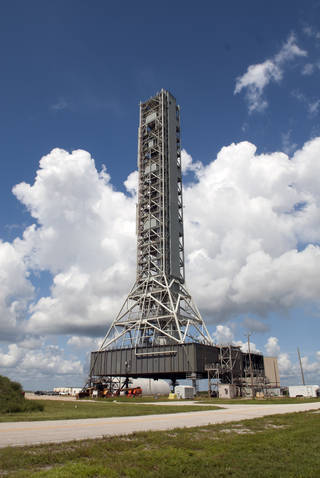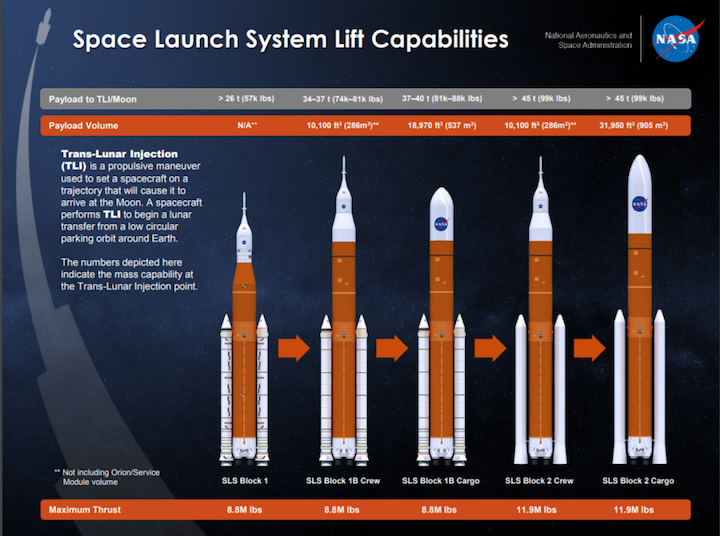28.04.2018

NASA’s Exploration Mission-2 (EM-2), the first launch of a crew on the new Space Launch System (SLS), is being revised now that NASA has permission to build a second Mobile Launch Platform (MLP) and has reassessed the costs of human-rating the Interim Cryogenic Propulsion Stage (ICPS). NASA’s Bill Gerstenmaier said today that the idea now is to launch EM-2 on the initial version of SLS with ICPS, not the upgraded design with the more capable Exploration Upper Stage (EUS), and to move EM-2 forward in time. Using the less capable ICPS means changing what EM-2 will do, however.
Gerstenmaier spoke at a Space Transportation Association meeting on Capitol Hill about NASA’s future human exploration plans. NASA is building a big new rocket, SLS, and crew spacecraft, Orion, to send astronauts back to the Moon and someday to Mars. NASA refers to the SLS/Orion launches as “Exploration Missions.” The first is EM-1, the second is EM-2, and so forth.
Development of SLS, Orion and the Exploration Ground Systems (EGS) to support them have been underway for many years. One ground system piece is the MLP, which supports assembly, testing, checkout and servicing of the rocket and transfers it from the Vehicle Assembly Building to the launch pad. NASA has only one MLP now, which originally was built for the now-cancelled Ares I rocket that was being developed for the Constellation program and has been modified for SLS.
Congress added $350 million to NASA’s FY2018 appropriations bill for NASA to build a second MLP. Without it, a 33-month hiatus will be required between EM-1 and EM-2.
EM-1 will be launched on the initial version of the SLS — Block 1 — which uses ICPS as a second stage. The next version — Block 1B — uses the much taller, heavier and more capable EUS. The existing MLP would have to be significantly modified to accommodate the greater weight and height of the SLS/EUS combination.
NASA is actually planning five versions of SLS, shown here in a NASA chart with their relative capabilities for placing metric tons of mass on a trajectory towards the Moon — Trans Lunar Injection (TLI).

EM-1 will send an uncrewed Orion spacecraft on a test mission around the Moon probably in 2020 using the Block 1 configuration.
EM-2, with a crew, has been planned for 2023 using Block 1B. In addition to launching the first Orion crew, EM-2 would deliver the Power and Propulsion Element (PPE) for the Lunar Orbital Platform-Gateway (LOP-G) to lunar orbit. LOP-G, previously called the Deep Space Gateway, will be a small space station in lunar orbit that serves as a transit point for crews headed to the lunar surface or to Mars.
The new plan is to use Block 1 for both EM-1 and EM-2 and perhaps other missions. Since Block 1 is less capable, EM-2 will have to be revised, however. For example, it cannot also launch the PPE. Gerstenmaier said today that a commercial launch will be procured for the PPE.
NASA actually was going to use Block 1 for both EM-1 and the EM-2 originally, but rockets that put people into space must meet stringent safety requirements, called “human rating.” Since all the other missions were to use the human-rated EUS, that would have meant spending substantial sums to human-rate ICPS for just one flight (the crewed EM-2). Therefore a decision was made to shift EM-2 to EUS to avoid the cost of human-rating ICPS. That meant that the first crew mission would have to wait those 33 months while the MLP was modified to accommodate EUS.
Getting a second MLP does not completely solve the time problem, however. Gerstenmaier said that it will take 5 years from procurement to delivery of the second MLP. Even if procurement began today, that means it would not be ready until 2023.
What may allow NASA to move up the EM-2 launch date is not just the second MLP, but a reassessment of the costs of human-rating ICPS. Gerstenmaier said that during last year’s study of whether it was feasible to put a crew on EM-1, the agency determined the cost of human-rating ICPS is less than they expected.
In a statement to SpacePolicyOnline.com, NASA said its contract with Boeing for the first ICPS included an option for a second, although the timeframe for exercising the option expired in August 2016. NASA will begin negotiations with Boeing for a second ICPS this summer. NASA also explained other changes to the EM-2 mission profile if it launches on a Block 1. Although it cannot take the PPE to lunar orbit, as noted above, it might take small secondary payloads like the 13 cubesats that will be on EM-1. Key objectives still can be met, however, including mission planning, system performance, crew interfaces, and navigation and guidance in deep space. NASA has not decided what the crew size will be, but four could be accommodated.
The bottom line is that the early SLS missions are in a state of flux, but NASA is doing what it can to accelerate when the first Orion crew will be launched.
The agency is also looking at other missions that could be flown on the Block 1, such as the robotic Europa Clipper mission to Jupiter’s moon Europa. Rep. John Culberson (R-Texas), chairman of the House Appropriations subcommittee that funds NASA, wrote into law that Europa Clipper must be launched by SLS in 2022. NASA’s FY2019 budget request said that it could not launch it on SLS before 2025 without disrupting its human spaceflight plans, but the second MLP may change that. At an April 12, 2018 NASA hearing before Culberson’s subcommittee, then NASA Acting Administrator Robert Lightfoot said NASA will decide later whether to launch Europa Clipper or the Orion crew as the second SLS mission, depending on which is ready first.
Separately, Gerstenmaier said at today’s briefing that NASA has released a synopsis of a NASA Research Announcement (NRA) it plans to release next month soliciting studies from U.S. private sector companies on how NASA can help them develop commercial space stations in low Earth orbit. NASA wants to end direct support for the International Space Station in 2025 and lease facilities or purchase services from the private sector instead of operating its own space station so it can focus on the Moon and Mars. An “industry day” will take place on May 1 at Johnson Space Center to discuss study objectives and proposal instructions.
Quelle: Space and Technology Policy Group
